- Home
- All Kinds of Palms
- Cold Weather Palms
Palms for Cold Weather
Transform Your Garden into a Tropical Oasis
Palms for cold weather are fitting for areas in Temperate Planting Zones. Even if you get occasional freezing temperatures, you can have a touch of the tropics in your garden!
Have you ever dismissed the idea because of your colder climate? Does it surprise you to learn that not all palm trees absolutely require a tropical climate? Maybe not!
Some palms can handle cold weather. For a time. The trick is to know which palms they are! And what their limits are.
Here's what we have to help you out:
Feeling overwhelmed by so many palm trees?
You're not alone. We Understand your headaches! At Mission: Palm Trees you'll find clear answers to questions & Step-By-Step Guidance, from real people. With solutions to help. No puzzling shoptalk. No tiring research. So it's easy & fun for you.
Understanding Planting Zones for Cold-Hardy Palms
Before figuring out which palms for cold weather are those you'd like...
- It's important to be aware of planting zones. For defining climatic conditions of your area. Choosing plants that can do well.
Mission: Palm Trees is made possible by readers like you! If you purchase via a link/ ad here, we may earn a small commission. At no added cost to you. Thanks for your support! Learn more>
- If you don't know your exact area's zone, Discover Your Planting Zone Now>
- Palm trees for cold weather can withstand temperatures below 32oF/0oC for brief periods. Some survive temperatures as low as 10-15oFahrenheit (-12.2o to -9.4oCelsius)
- Cold-hardy palms are adaptable. Their pluckiness means growing them in USDA hardiness zones 7-9 is doable. And with care, (like giving them A Winter Coat 😉) perhaps lower!
 They Forgot to Shield Their Palm from Winter Frost!
They Forgot to Shield Their Palm from Winter Frost!One resource, Palms Won't Grow Here and Other Myths (highly recommended for adventurous palm lovers), says there are 100+ palm species that are known to tolerate 20oF/-7oC for a short time. Some of those, even can manage lower temps.
We've seen palms growing in coastal Norway, in northern Germany & up in New Jersey, USA! Certainly must be palms for cold weather.
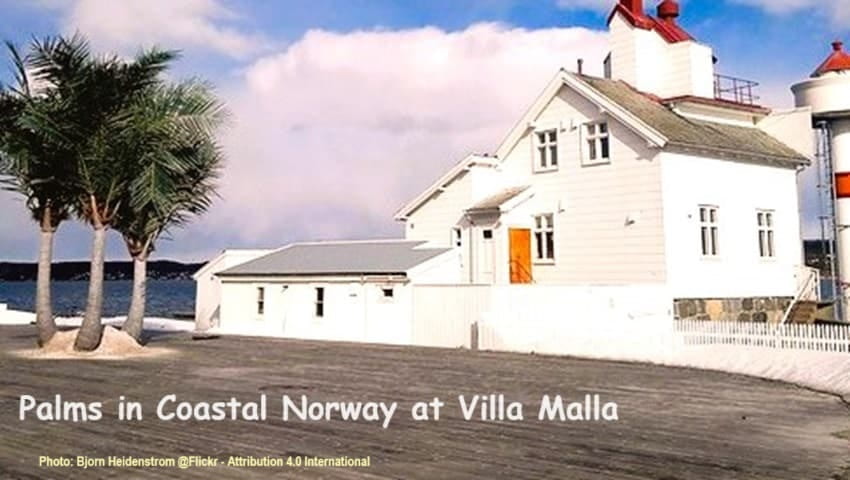
Top Cold-Hardy Palm Species for Your Garden
There are a variety of cold hardy palm trees. Let's figure out which would be happy in your yard!
Our Top Picks: 5 of the Best Cold-Hardy Palms
Windmill Palm - A Sturdy Cold-Weather Palm
This species, Trachycarpus fortunei, suited for cold weather, is one of the most common types of Cold-Hardy Palms. Probably because it originated in cold mountain regions of China.
It's a Favorite Among Palm Aficionados in cooler climates. Preferring nippy Mediterranean climes with full sun & without continuous wind. It has distinctive windmill-shaped fronds. It's best in Zones 7b-11, but has survived well is some 7a microclimates.
This palm can handle temperatures down to -10F (-23C)!
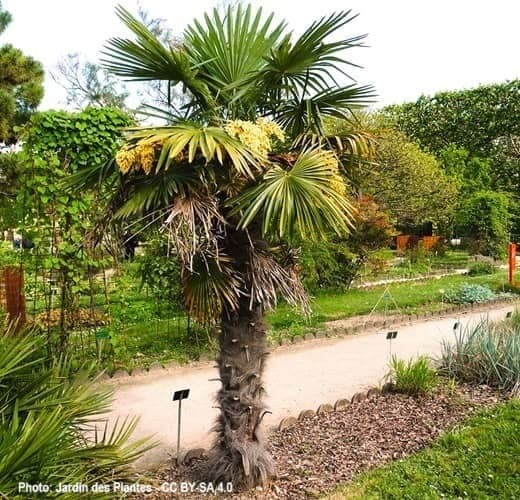 Flourishing Windmill Palm at Jardin des Plantes, France
Flourishing Windmill Palm at Jardin des Plantes, FranceIdeal for Cold Weather Gardens
Needle Palm - The Ultimate Frost-Resistant Palm
Rhapidophyllum hystrix is another fabulous species to consider when you need a palm for cold weather areas. Palm Horticulturists applaud it as one of the hardiest palms out there. Even in Zones 5 & 6. But not at all worrisome up to Zone 10.
It can shrug off temperatures hitting -5oF to -20oF (-21C to -29C). Sometimes lower, as there's one known in Wisconsin's Zone 3b!
It's a surprise really, as they're originally from the southeastern States of The U.S.
It's a species that survives drought & some neglect. Needs placement where there's a good amount of daily shade. Regular watering is best though, as an endemic area is swamps. But flexible for soil.
The perfect fit for your cooler area.
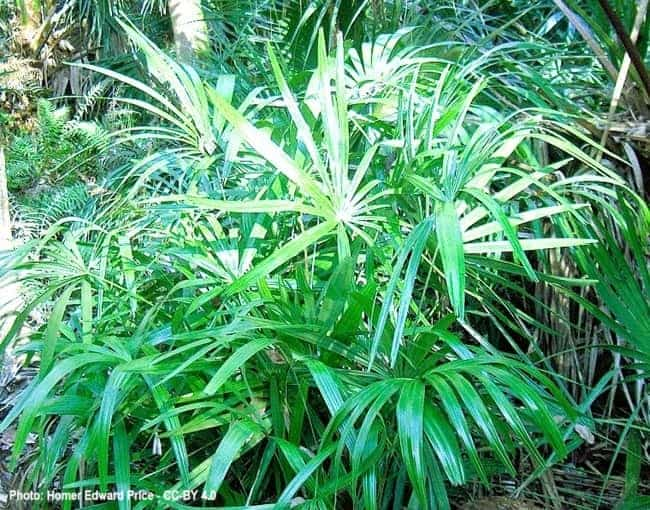 Resilient Needle Palm - Perfect for Your Frost-Resistant Greenery
Resilient Needle Palm - Perfect for Your Frost-Resistant GreeneryEuropean Fan Palm - Versatile and Hardy
Chamaerops humilis, also goes by Mediterranean Palm, as it's native to Mediterranean regions. These usually clumping cold tolerant palm is suitable for Zones 8b-11 & dry climes of 8a.
A versatile species, it survives some challenging environmental conditions, from extreme cold to drought.
- Ensure the soil is well-draining in a sunny area.
- Avoid surrounding it with dense flora that cuts air circulation.
- Tolerates temps as low as 15°F/-9°C, particularly in arid climes.
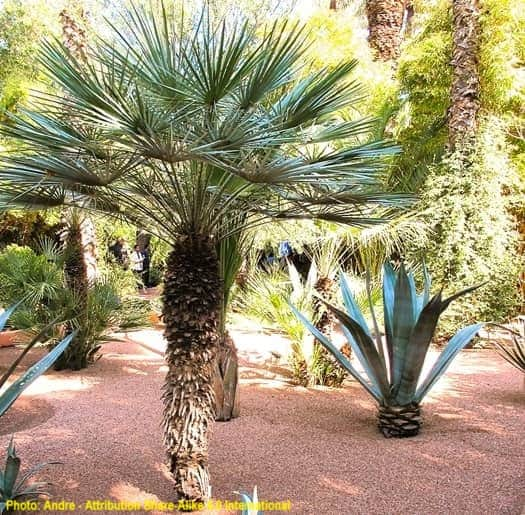 European Fan Palm (Chamaerops humilis var. Argentea)
European Fan Palm (Chamaerops humilis var. Argentea)Solitary Trunk Variant can fit Colder Climates.
But not the most cold hardy version.
Dwarf Palmetto - Compact and Cold-Tolerant
Sabal minor, also called Bush Palmetto & Swamp palmetto.
- It does fine in Zones 6-11. Even has been grown in Zone 5.
- Most grow in a clumping manner, with underground trunks. Even useful for groundcover.
- It likes moist soil & shady times for much of the day.
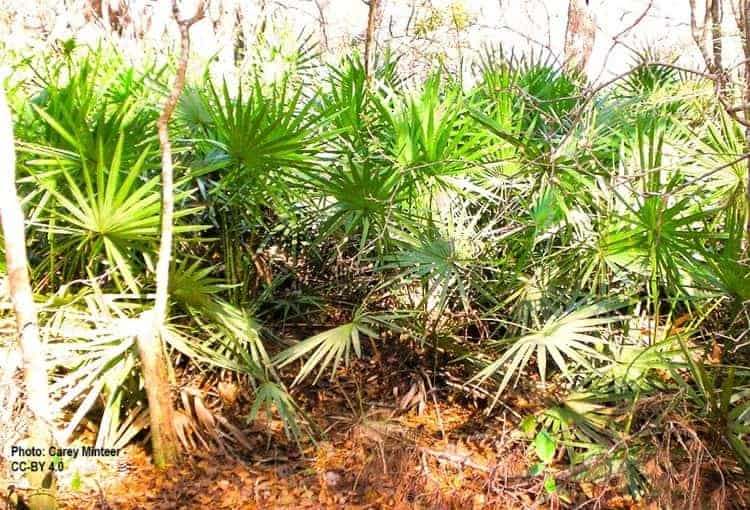 Wild Dwarf Palmetto growing in the Southeast U.S. - Yet Hardy in Cold Weather
Wild Dwarf Palmetto growing in the Southeast U.S. - Yet Hardy in Cold WeatherCalifornia Fan Palm - Majestic and Yet Gritty
Washingtonia filifera is best for Zones 7-8.
- It's known to survive short-term temps as low as -11oF/-24oC!
- Not so worrisome with a drop to 20oF/-7oC.
It's believed it can better tolerate low temps in a drier clime. As such, it's drought tolerant.
A Mediterranean climate is ideal. These are among the famed Palm on the Streets of LA. So note if this Tall Palm would fit into your own landscape.
 Artistic Representation of Cold-Hardy California Fan Palms
Artistic Representation of Cold-Hardy California Fan PalmsNewest Palm Article
-
Interesting Facts About Palm Trees - Uncover Exotic Secrets
Explore interesting facts about palm trees, including their evolutionary traits, culinary contributions, iconic landscapes , and astonishing durability.
Additional Palms for Slightly Milder Climates
More options exist if your climatic conditions are a bit less harsh. Excellent choices for those living in slightly milder, but still cold winter areas.
Pindo Palm - A Drought Tolerant, Cold-Hardy Gem
Known as the most cold-hardy pinnate palm tree. Butia capitata is renowned for its silvery-blue fronds and sweet fruit. There are many hybrid Butias out there, and they're all palms for cold weather.
- Zones 9-11 is ideal.
- Yet it can withstand temperature lows of -10F/-23C.
- For drier climates, go with Zones 8-11. This drought tolerant palm does do best with regular water.
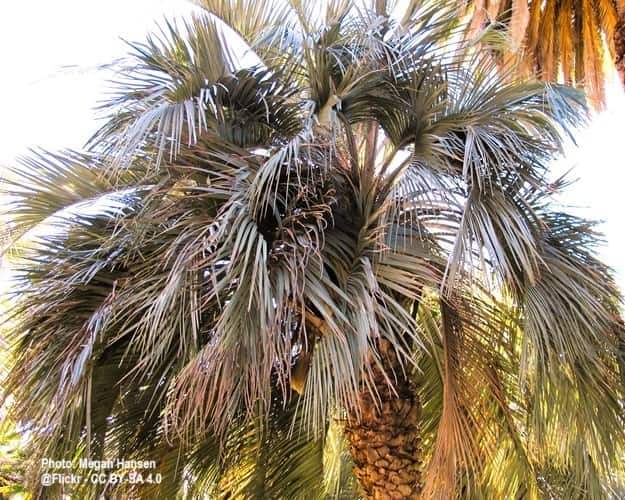 Pindo Palms Have Edible Fruit - A Hardy & Productive Cold-Weather Palm
Pindo Palms Have Edible Fruit - A Hardy & Productive Cold-Weather PalmPygmy Date Palm - So Attractive When Planted in Threes
Phoenix roebelinii is a Small-Sized Palm.
- Does well in Zones 10-11.
- It's been tried in 9b with success, especially when using cold protective measures.
- It can temporarily tolerate temperatures just below freezing.
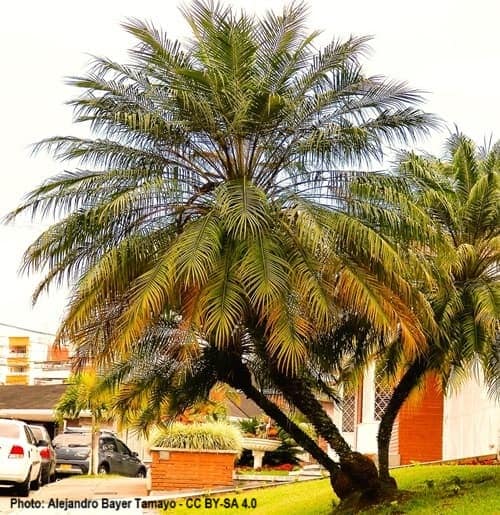 Pygmy Date Palms in a Trio - Beauty in Colder Climates
Pygmy Date Palms in a Trio - Beauty in Colder ClimatesBrazilian Needle Palm - Cold Hardy Palm Trees
Is its striking trunk acting like an overcoat against the chill!? 🤔As Trithrinax brasiliensis wears a fibrous weave with intermittent pointy spines. Though it can't tolerate low temps for long.
- Growing slowly to reach only about 35ft/11.7m up.
- It prefers drier climates like in its native Brazilian savannahs.
- Which takes it to Zones 8-11.
More humid areas are doable, but then the lowest Zone is 9.
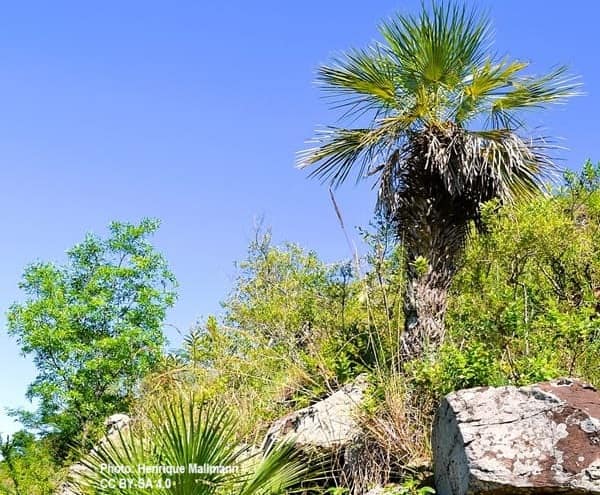 Cold-Hardy Brazilian Needle Palm in Its Native Habitat, Brazil
Cold-Hardy Brazilian Needle Palm in Its Native Habitat, BrazilPreventing & Managing Cold Weather Damage in Palms
Whichever palm for cold weather you decide upon, there are consequences if the temperature dips too low. Especially when it lasts for days.
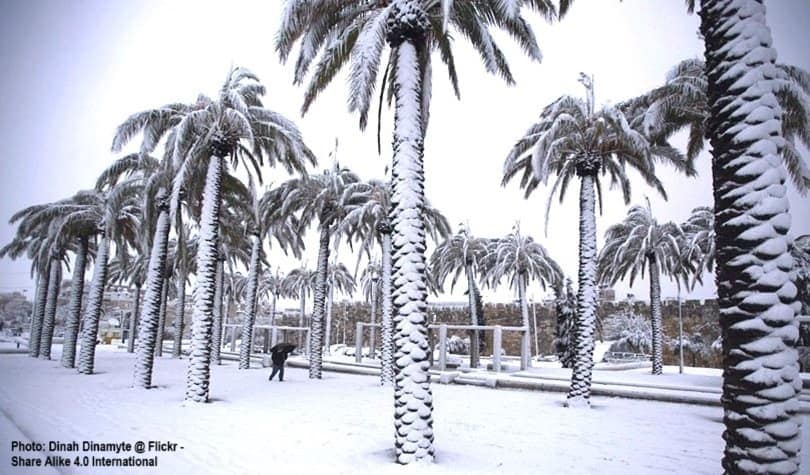 Snow-Covered Palms - Need Assessment Over Time for Cold Weather Damage
Snow-Covered Palms - Need Assessment Over Time for Cold Weather DamageThere's never an exact temperature cut-off. Other circumstances besides temperature contribute to a palm's freeze survival - or NOT!
- Overall, the younger the palm, the more frost harms it. Seedlings are most vulnerable. If less than 4-years old, protection needed on cold winter nights.
- Palms grow 3 years to become established. Then it's more hardy overall.
- Some Palm Tree Parts withstand freezing temps easier than others. Most cold-sensitive areas are root tips, flowers & leaf bases. Oldest fronds take cold much better than newer ones.
- Strong cold winds and lengthy freeze times lessen even cold hardy palms' endurance.
Frost damaged palm trees show signs.
- Blackish squooshy frond areas, red blotches, and/or yellow smudges.
- When temps dip further below freezing, petioles, rachis, meristem & trunk can suffer.
See more on Palm Freeze Damage.
FAQ of Palms for Cold Weather
Do any palms grow okay in USDA Climate Zone 6?
Do any palms grow okay in USDA Climate Zone 6?
With watchfulness The Needle Palm does fine in USDA Climate Zone 6. Another that is best among cold weather palms is The Dwarf Palmetto.
Why can't palm trees grow in colder climates?
Why can't palm trees grow in colder climates?
Palms are naturally designed for warmer environments. But a range exists according to species' evolution:
- Some love hottest & sunniest places.
- The other extreme: Growing where they've acclimated to colder times.
The biology of palms answers this question:
- As non-woody plants, they have a higher percentage of internal water.
- Adding to this, they can't generate their own heat, as warm-blooded animals do.
- When temperatures drop, ice crystals form in their body crevices & tubes. Causing damage to essential plant cells.
Cold hardy palm trees evolved over centuries to tolerate lower temperatures, because of Where They Natively Developed. Tropical/subtropical species never had to do that.
Which are fast growing cold hardy palms?
Which are fast growing cold hardy palms?
Most palms for cold weather aren't fast growing. But a few to mention are:
Washingtonia robusta - An established Mexican Fan Palm grows pretty quickly. But remember, it gets tall. It's those California Tall Palms.
Livistonia chinensis - Chinese Fan Palms grow somewhat quickly. Preferring Zones 8b-11. But if placed in shady areas, it's done ok in Zones 6-8a. Even seen in Zone 5! But if it gets below 23oF/-5oC, fronds can die off & you may think it's dead. But often it revives, so use our Freeze Damage Tips to help.
Mule Palms - Hybrid, xButyagrus nabonnandii is ok 8b-11. Grows quickly with good care.
Creative Landscaping with Palms for Cold Weather
Pair these palms with the right companions. Complementing them with shrubs and trees to provide wind protection. Helping them through cold nights. For instance:
- Henry Hicks Sweet Bay Magnolia - The Magnolia virginiana var. Australis 'Henry Hicks' tolerates planting in Zones 5-9. Can grow to 60ft/18m, making a beautiful wind-break.
- Blanchard Southern Magnolia also works in Zones 6b+.
- Mediterranean Heather - Erica carnea does well in Zones as low as 6. Also 5, with winter protection. It's an evergreen mounding shrub. Give organic mulching. Needs acidic soil, good drainage & a sunlit spot.
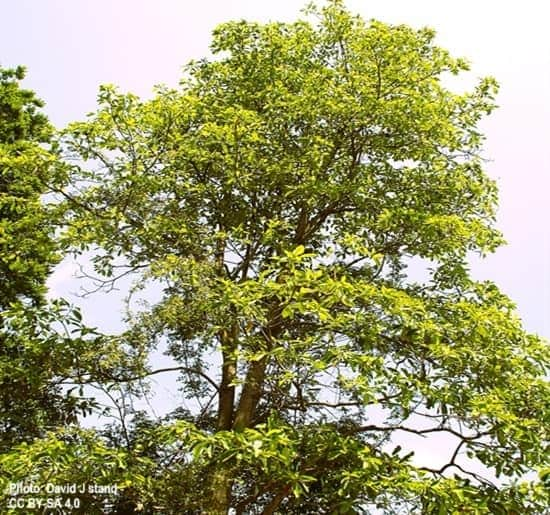 Sweet Bay Magnolia (Magnolia virginiana var. Australis) - A Reliable Windbreak for Palms
Sweet Bay Magnolia (Magnolia virginiana var. Australis) - A Reliable Windbreak for Palms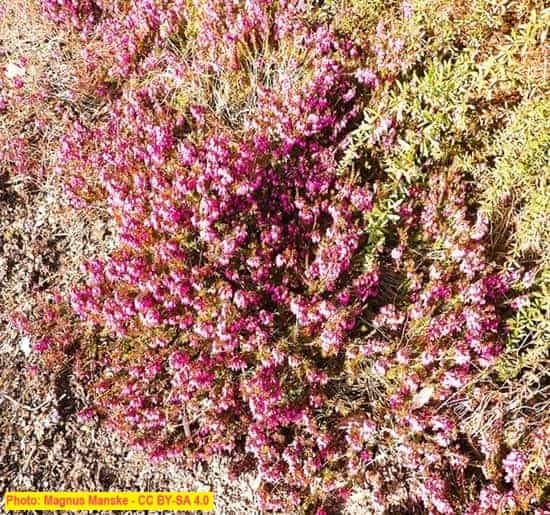 Mediterranean Heather (Erica carnea var. Challenger) - Ideal Companion for Cold-Hardy Palms
Mediterranean Heather (Erica carnea var. Challenger) - Ideal Companion for Cold-Hardy PalmsPlants with contrasting textures or colors brighten up your winter's day. They might even add value to your home.
Remember, it’s not enough to Select Cold-Hardy Species when planning your tropical paradise. You want the right plant (palm) for cold weather planted in the right place. Giving them proper soil, the right watering plan, and needed sunlight.
Final Thoughts on Growing Palms in Cooler Climates
Don't let your cool climate hold you back from creating your tropical garden. Cold-hardy palm trees can thrive and flourish in non-tropical climates.
With the right research, care, and maintenance, you could soon be enjoying your own little slice of paradise. By using palms with cold weather tolerance.





